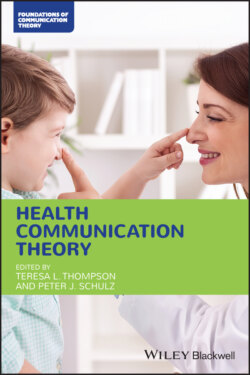Читать книгу Health Communication Theory - Группа авторов - Страница 17
Why Do We Need Health Communication Theory?
ОглавлениеAs is the case with any area of scholarly study, health communication work that is guided by a theoretical framework is stronger than work that is atheoretical. Some work that falls within the general category of health communication is problem‐focused but not theoretically framed. Work that is based in theory is more systematic than is work that is problem‐oriented but atheoretical. Work that is grounded in theory is generalizable beyond the particular context or health condition that was the focus of the original study. Good theories are not content‐ or health‐problem‐specific. They apply to broader communicative processes, not just to a particular health problem or in a particular setting. Good theory is, most importantly, practical and applicable to social concerns.
If a study on diabetes management is grounded in a perspective such as the theory of reasoned action, findings from that study will provide insights that scholars may apply to other health problems and contexts. Although generalizability is partially based on sampling, design issues, and ecological validity concerns, it is also based on theoretical framing. Through the theoretical grounding of a study the broader base of knowledge is extended. This is the goal of scholarship. This is how a body of knowledge is built.
One of the more interesting examples of theory being extended into new areas of study is cybersecurity. If imitation is the sincerest form of flattery, theories of health and health communication should at least blush occasionally. Several theories discussed within this volume have gained theoretical traction in research on computer security.
Scholars studying how to motivate end users to engage in safe computer practices use the health belief model (Rosenstock 1974), the protection motivation theory (Rogers 1975), and the transtheoretical model (Prochaska and DiClemente 1983) to guide their research.
For example, Ng et al. (2009) found that perceptions of susceptibility, benefits, and feelings of self‐efficacy were the best predictors of opening email attachments. The analogue of “don’t click on links or open unexpected email attachments” in the realm of health is “maintain social distance and wash your hands.” Viruses move through contact and malware moves through virtual contact or email.
Recently researchers from Carnegie Mellon (Faklaris, Dabbish, and Hong 2018) recognized the value of the transtheoretical model for designing security interventions. Their recommendations acknowledge that, just like the public in a general health information campaign, end users are not equally accepting or ready for making changes to their behavior. By targeting messages based on users’ current readiness or stage of change, cybersecurity professionals may increase the effectiveness of their campaigns and training materials. Also important, developing targeted messages may help reduce the feelings of cyber‐fatigue that are now recognized as the bane of security training efforts.
Training programs for avoiding phishing attacks and ransomware attacks require different lists of rules. It is no wonder that end users receiving information not targeted to their readiness produce fatalistic attitudes about cybersecurity training.
Fortunately, health communication theory has come to the rescue here, too. Recent research by Zhang and Borden (2019) employed the extended parallel processing model (Witte 1994) and found fear and anxiety mediated end‐user behavior. Specifically, negative emotions were shown to influence the impact of threat on end‐user intentions to comply and seek additional information. Efforts to motivate end‐user cybersecurity behavior need to consider the role self‐efficacy plays in the process. It remains to be seen how effective these theories will be, but it is clear scholars from other disciplines are looking to health and health communication for theoretical models. The next section of this chapter focuses on the different types of theories. The breadth and depth of these theoretical traditions have certainly helped us grow the discipline.
